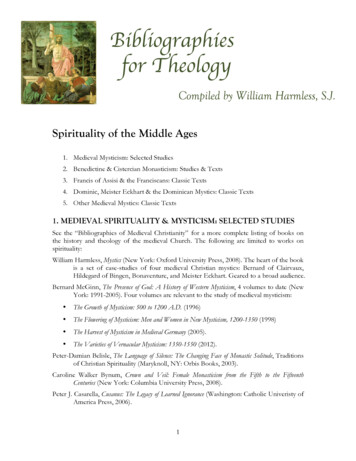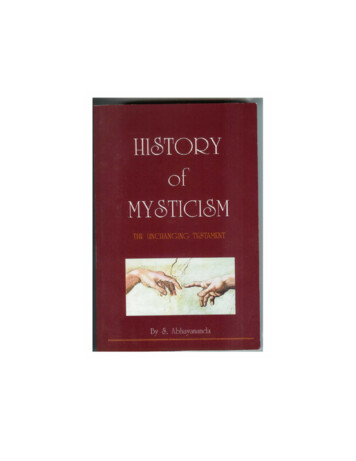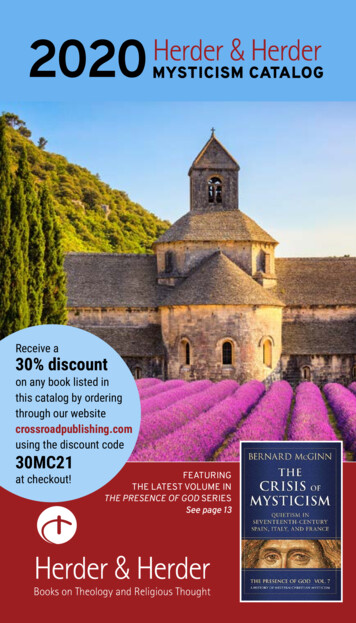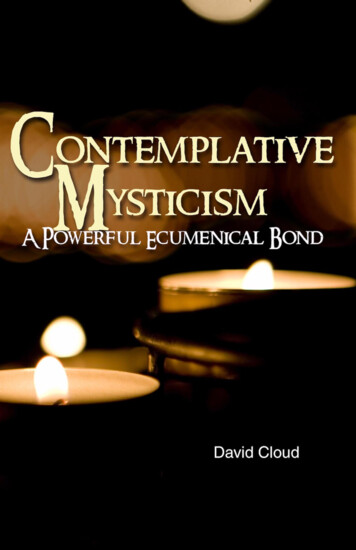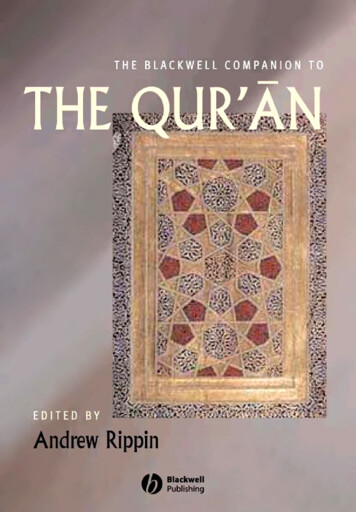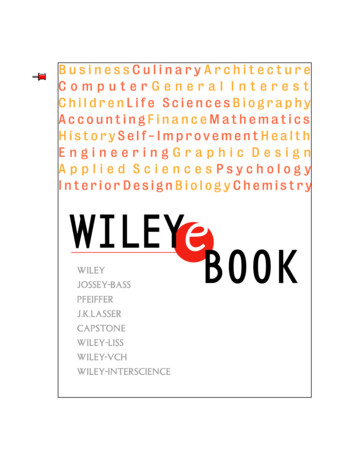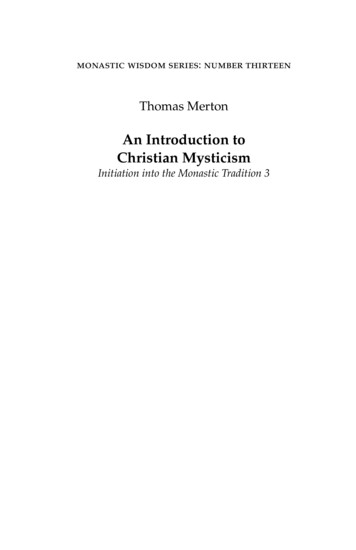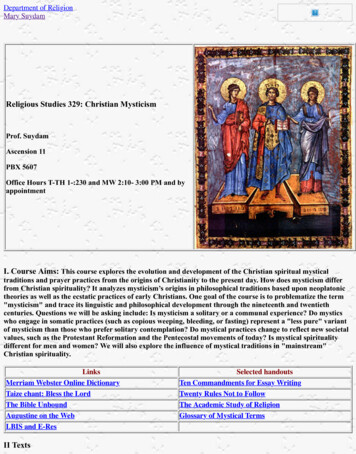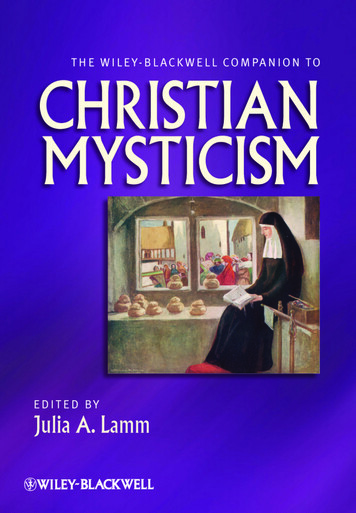
Transcription
The Wiley-BlackwellCompanion to ChristianMysticism
The Wiley-Blackwell Companions to ReligionThe Wiley-Blackwell Companions to Religion series presents a collection of the most recentscholarship and knowledge about world religions. Each volume draws together newlycommissioned essays by distinguished authors in the field, and is presented in a style which isaccessible to undergraduate students, as well as scholars and the interested general reader. Thesevolumes approach the subject in a creative and forward-thinking style, providing a forum inwhich leading scholars in the field can make their views and research available to a wideraudience.Recently PublishedThe Blackwell Companion to the Study of ReligionEdited by Robert A. SegalThe Blackwell Companion to the Qur’ānEdited by Andrew RippinThe Blackwell Companion to Contemporary Islamic ThoughtEdited by Ibrahim M. Abu-Rabi‛The Blackwell Companion to the Bible and CultureEdited by John F. A. SawyerThe Blackwell Companion to CatholicismEdited by James J. Buckley, Frederick Christian Bauerschmidt, and Trent PomplunThe Blackwell Companion to Eastern ChristianityEdited by Ken ParryThe Blackwell Companion to the TheologiansEdited by Ian S. MarkhamThe Blackwell Companion to the Bible in English LiteratureEdited by Rebecca Lemon, Emma Mason, John Roberts, and Christopher RowlandThe Blackwell Companion to the New TestamentEdited by David E. AuneThe Blackwell Companion to Nineteenth Century TheologyEdited by David FergussonThe Blackwell Companion to Religion in AmericaEdited by Philip GoffThe Blackwell Companion to JesusEdited by Delbert BurkettThe Blackwell Companion to PaulEdited by Stephen WesterholmThe Blackwell Companion to Religion and ViolenceEdited by Andrew R. MurphyThe Blackwell Companion to Christian Ethics, Second EditionEdited by Stanley Hauerwas and Samuel WellsThe Wiley-Blackwell Companion Practical TheologyEdited by Bonnie J. Miller-McLemoreThe Wiley-Blackwell Companion to Religion and Social JusticeEdited by Michael D. Palmer and Stanley M. BurgessThe Wiley-Blackwell Companion to Chinese ReligionsEdited by Randall L. NadeauThe Wiley-Blackwell Companion to African ReligionsEdited by Elias Kifon BongmbaThe Wiley-Blackwell Companion to Christian MysticismEdited by Julia A. Lamm
The Wiley-BlackwellCompanion to ChristianMysticismEdited byJulia A. LammA John Wiley & Sons, Ltd., Publication
This edition first published 2013 2013 Blackwell Publishing LtdBlackwell Publishing was acquired by John Wiley & Sons in February 2007. Blackwell’s publishingprogram has been merged with Wiley’s global Scientific, Technical, and Medical business to formWiley-Blackwell.Registered OfficeJohn Wiley & Sons Ltd, The Atrium, Southern Gate, Chichester, West Sussex, PO19 8SQ, UKEditorial Offices350 Main Street, Malden, MA 02148-5020, USA9600 Garsington Road, Oxford, OX4 2DQ, UKThe Atrium, Southern Gate, Chichester, West Sussex, PO19 8SQ, UKFor details of our global editorial offices, for customer services, and for information about how to apply forpermission to reuse the copyright material in this book please see our website at www.wiley.com/wiley-blackwell.The right of Julia A. Lamm to be identified as the author of the editorial material in this work has beenasserted in accordance with the UK Copyright, Designs and Patents Act 1988.All rights reserved. No part of this publication may be reproduced, stored in a retrieval system, ortransmitted, in any form or by any means, electronic, mechanical, photocopying, recording or otherwise,except as permitted by the UK Copyright, Designs and Patents Act 1988, without the prior permission ofthe publisher.Wiley also publishes its books in a variety of electronic formats. Some content that appears in print maynot be available in electronic books.Designations used by companies to distinguish their products are often claimed as trademarks. All brandnames and product names used in this book are trade names, service marks, trademarks or registeredtrademarks of their respective owners. The publisher is not associated with any product or vendormentioned in this book. This publication is designed to provide accurate and authoritative information inregard to the subject matter covered. It is sold on the understanding that the publisher is not engaged inrendering professional services. If professional advice or other expert assistance is required, the services ofa competent professional should be sought.Library of Congress Cataloging-in-Publication DataThe Wiley-Blackwell companion to Christian mysticism / edited by Julia A. Lamm.p. cm.Includes bibliographical references and index.ISBN 978-1-4443-3286-5 (cloth)1. Mysticism. I. Lamm, Julia A., 1961– II. Title: Companion to Christian mysticism.BV5082.3.W55 2013248.2'2–dc232012015886A catalogue record for this book is available from the British Library.Cover image: Lady Julian of Norwich, illustration by Stephen Reid from The Mighty Army byWinifred M. Letts, 1912, color lithograph. AlamyCover design by Nicki Averill.Set in 10/12.5 pt Photina by Toppan Best-set Premedia Limited1 2013
For Alan and Aidan
ContentsNotes on ContributorsPreface1A Guide to Christian MysticismJulia A. LammPart I Themes in Christian Mysticismxixix1252The Song of SongsAnn W. Astell and Catherine Rose Cavadini273GenderBarbara Newman414PlatonismWillemien Otten565AestheticsDon E. Saliers746HeresyJ. Patrick Hornbeck II89Part IIEarly Christian Mysticism1037Mysticism in the New TestamentAlan C. Mitchell1058The Judaean–Jewish Contexts of Early Christian MysticismOri Z Soltes1199“Mysticism” in the Pre-Nicene Era?Bogdan G. Bucur133
viii CONTENTS10Origen and His FollowersAugustine Casiday14711Negative Theology from Gregory of Nyssa to Dionysius the AreopagiteCharles M. Stang16112Syriac MysticismBrian E. Colless17713Mysticism and Contemplation in Augustine’s ConfessionsJohn Peter Kenney19014Augustine’s Ecclesial MysticismJ. Patout Burns20215Benedictine Monasticism and MysticismColumba Stewart, O.S.B.216Part IIIMedieval Mystics and Mystical Traditions23516Bernard of Clairvaux and the Cistercian Mystical TraditionBrian Patrick McGuire23717The VictorinesBoyd Taylor Coolman25118The Mystery of Divine/Human Communion in the Byzantine TraditionGeorge E. Demacopoulos26719Francis, Clare, and BonaventureKevin L. Hughes28220The Nuns of HelftaAnna Harrison29721Mysticism in the Spiritual Franciscan TraditionMichael F. Cusato, O.F.M.31122The Low Countries, the Beguines, and John RuusbroecHelen Rolfson, O.S.F.32923Meister Eckhart, Johannes Tauler, and Henry SusoCharlotte C. Radler34024The Late Fourteenth-Century English MysticsChristiania Whitehead35725Late Medieval Italian Women MysticsArmando Maggi37326Nicholas of Cusa and the Ends of Medieval MysticismPeter J. Casarella388
CONTENTSPart IVixMysticism and Modernity40527The Protestant Reformers on MysticismDennis E. Tamburello, O.F.M.40728Spanish Mysticism and Religious Renewal: Ignatius of Loyola,Teresa of Avila, and John of the CrossEdward Howells42229Seventeenth-Century French MysticismWendy M. Wright30The Making of “Mysticism” in the Anglo-American World:From Henry Coventry to William JamesLeigh Eric Schmidt452“We Kiss Our Dearest Redeemer through Inward Prayer”:Mystical Traditions in PietismRuth Albrecht4733143732Nineteenth- to Twentieth-Century Russian MysticismPaul L. Gavrilyuk48933Modern Catholic Theology and Mystical TraditionStephen M. Fields, S.J.50134Mystics of the Twentieth CenturyMary Frohlich, R.S.C.J.515Part VCritical Perspectives on Mysticism53135A Critical Theological PerspectivePhilip Sheldrake53336What the Saints Know: Quasi-Epistemological ReflectionsJames Wetzel55037Mysticism and the VernacularDenis Renevey56238The Social Scientific Study of Christian MysticismRalph W. Hood, Jr. and Zhuo Chen57739NeuroscienceDouglas E. Anderson59240Christian Mysticism in Interreligious PerspectiveLeo D. Lefebure610Index626
Notes on ContributorsRuth Albrecht is Professor of Church History at the University of Hamburg. Shespecializes in monasticism, the social history of gender and piety, Pietism, and Protestant reform movements of the nineteenth and twentieth centuries. Her publicationsinclude Das Leben der heiligen Makrina auf dem Hintergrund der Thekla-Traditionen. Studienzu den Ursprüngen des weiblichen Mönchtums im 4. Jahrhundert in Kleinasien (1986);Johanna Eleonora Petersen. Theologische Schriftstellerin des frühen Pietismus (2005); AdelineGräfin von Schimmelmann. Adlig. Fromm. Exzentrisch, co-editor (2011); and Fairy vonLilienfeld (1917–2009), co-editor (2011).Douglas E. Anderson is Professor in the Department of Neurological Surgery at theStritch School of Medicine, Loyola University Medical Center, Maywood, Illinois. Hemaintains a large clinical practice with specialization in benign skull base tumors,the surgical treatment of trigeminal neuralgia and autonomic cephalgias, functionalsurgery for movement disorders, intractable psychiatric conditions, and epilepsy surgery.He has written several book chapters, hundreds of abstracts and presentations, andover fifty papers in refereed journals. He is the baritone soloist for the Grace LutheranBach Cantata Vesper Series and a featured soloist with Chicago’s Music of the Baroquechorus and orchestra.Ann W. Astell is Professor of Theology at the University of Notre Dame. She was Professor of English and Medieval Studies at Purdue University from 1988 until 2007. Theauthor of six books, beginning with The Song of Songs in the Middle Ages (1990) andincluding, recently, Eating Beauty: The Eucharist and the Spiritual Arts of the Middle Ages(2006); she is also the editor or co-editor of five collections of essays, including LaySanctity, Medieval and Modern: The Search for Models (2000), Joan of Arc and Spirituality(2003), and Sacrifice, Scripture, and Substitution: Readings in Ancient Judaism and Christianity (2011).Bogdan G. Bucur is Assistant Professor of Theology at Duquesne University. Hisresearch explores the intersection of biblical exegesis, doctrinal development, andspirituality in early Christianity and Byzantium. Aside from several articles, he is the
xii NOTES ON CONTRIBUTORSauthor of Angelomorphic Pneumatology: Clement of Alexandria and Other Early ChristianWitnesses (2009).J. Patout Burns is Edward A. Malloy Professor of Catholic Studies, Emeritus, Vanderbilt University Divinity School. His research has been primarily into the practice andtheology of North African Christianity. His publications include The Development ofAugustine’s Doctrine of Operative Grace, Cyprian the Bishop, and Romans in The Church’sBible series.Peter J. Casarella is Professor of Catholic Studies and Director of the Center for WorldCatholicism and Intercultural Theology at DePaul University. He edited Cusanus: TheLegacy of Learned Ignorance and is President of the American Cusanus Society.Augustine Casiday is Senior Lecturer in Historical Theology at the University ofWales, Trinity Saint David, and a fellow of the Royal Historical Society. His research todate has focused on early Christian asceticism and his resultant publications includeTradition and Theology in St. John Cassian, Evagrius Ponticus, and (with Tim Vivian) Markthe Monk: Counsels on the Spiritual Life. He also studies the modern practices of interpreting and receiving ancient and medieval Christian teachings, with particular emphasison contemporary western responses to eastern Christianity. A book on that topic isforthcoming (Remember the Days of Old), as is an edited volume on a broadly relatedtopic (The Orthodox Christian World).Catherine Rose Cavadini teaches in the Department of Theology at the Universityof Notre Dame, where she is Assistant Chair of the Department and Director of theMasters Program. Her area of research is in the history of Christianity and medievaltheology. Her dissertation (2010) is entitled “The Commercium of the Kiss Who Saves:A Study of Thomas the Cistercian’s In Cantica Canticorum.”Zhuo Chen obtained his M.S. degree in psychology from the University of Tennesseeat Chattanooga where he is adjunct professor of psychology. Before that he studiedphilosophy at Wuhan University of China. He currently is active in research in thepsychology of religion, with added research interests in personality and culture andthe study of ambiguity and certainty.Brian Edric Colless is a graduate of Sydney University and Melbourne University;from 1970 until 2001 he taught religious studies at Massey University (New Zealand)and is currently an Honorary Research Associate there; publications include TheWisdom of the Pearlers (2008) and The Maharajas of the Isles (2007, with Roy Jordaan).Boyd Taylor Coolman is Associate Professor of Theology at Boston College. He is theauthor of Knowing God by Experience: The Spiritual Senses in the Theology of William ofAuxerre (2004) and The Theology of Hugh of St. Victor: An Interpretation (2010). He isco-editor of Trinity and Creation in Victorine Texts in Translation, Exegesis, Theologyand Spirituality from the Abbey of St. Victor (2010).
NOTES ON CONTRIBUTORSxiiiMichael F. Cusato, O.F.M. is the former Director of the Franciscan Institute and Deanof the School of Franciscan Studies at St. Bonaventure University in western New YorkState. He is currently adjunct professor at the Dominican House of Studies in Washington, D.C. A specialist in medieval Franciscan history, he has published widely on variousaspects of the minorite phenomenon. He has especially written on the Early Franciscanrule, the encounter between Francis of Assisi and the sultan al-Kamil, the stigmatizationaccounts, the career of Elias of Cortona, and aspects of the Spiritual Franciscans.George E. Demacopoulos is Associate Professor of Theology and Co-Founding Director of the Orthodox Christian Studies Program at Fordham University. His researchemphasizes points of contact and discord between Christian east and Christian westfrom late antiquity to the early modern period. His monograph, Five Models of SpiritualDirection in the Early Church explores the impact of the ascetic movement on prac tice of spiritual direction. He has also completed work on a second monograph thatexamines the creation and reception of a Petrine discourse at the end of Christianantiquity.Stephen M. Fields, S.J. is Associate Professor of Theology at Georgetown University.He has published Being as Symbol (2000) and articles on God’s relation with the world,nature and grace, Newman, recent papal thought, and Catholic higher education.Mary Frohlich, R.S.C.J. is Associate Professor of Spirituality at Catholic TheologicalUnion in Chicago. She is author of The Intersubjectivity of the Mystic: A Study of Teresaof Avila’s Interior Castle (1993) and editor of The Lay Contemplative (2000) andSt. Therese of Lisieux: Essential Writings (2003). Her areas of expertise includeCarmelite spirituality, mysticism, ecospirituality, and methodological issues in the studyof spirituality.Paul L. Gavrilyuk is Associate Professor of Historical Theology, Theology Department,University of St. Thomas, Saint Paul, Minnesota. He is the author of The Suffering of theImpassible God: The Dialectics of Patristic Thought (2004) and Histoire du catéchuménatdans l’Église ancienne (2007). He also co-edited with Sarah Coakley, The Spiritual Senses:Perceiving God in Western Christianity (2011).Anna Harrison is Associate Professor of Theological Studies at Loyola MarymountUniversity. She is the recipient of a 2010–2011 National Endowment for the Humanities Fellowship for her book project, “Thousands and Thousands of Lovers”: Sense of Community Among the Nuns of Helfta.Ralph W. Hood, Jr. is Professor of Psychology at the University of Tennessee at Chattanooga. He is a former editor of the Journal for the Scientific Study of Religion and formerly co-editor of the International Journal for the Psychology of Religion and the Archivefor the Psychology of Religion. He is a past president of division 36 (psychology of religion) of the American Psychological Association and a recipient of its William James,Mentor, and Distinguished Service awards.
xiv NOTES ON CONTRIBUTORSJ. Patrick Hornbeck II is Assistant Professor of Theology and Medieval Studies atFordham University. He is the author of What Is a Lollard? and co-editor of WycliffiteControversies and Wycliffite Spirituality.Edward Howells is Lecturer in Christian Spirituality at Heythrop College, Universityof London. He has written John of the Cross and Teresa of Avila: Mystical Knowing andSelfhood (2002) and various articles on mystical theology.Kevin L. Hughes is Associate Professor in the departments of Humanities and Theology at Villanova University. He is the author of Constructing Antichrist (2005) and coeditor of Augustine and Politics (2005) and Augustine and Liberal Education (2008). Hiscurrent research in medieval historical theology focuses on St. Bonaventure and theFranciscan tradition.John Peter Kenney is Professor of Religious Studies at Saint Michael’s College. He waspreviously Professor of Religion and Humanities at Reed College. He is the author ofMystical Monotheism: A Study in Ancient Platonic Theology (1991), The Mysticism of SaintAugustine: Rereading the Confessions (2005), and Contemplation and Classical Christianity(forthcoming).Julia A. Lamm is Associate Professor of Theology at Georgetown University. She isauthor of The Living God: Schleiermacher’s Theological Appropriation of Spinoza (1996)and co-editor and translator of Schleiermacher: The Christmas Dialogue and Other Selections, Classics of Western Spirituality (forthcoming).Leo D. Lefebure is the Matteo Ricci, S.J., Professor of Theology at Georgetown University. He is the co-author of The Path of Wisdom: A Christian Commentary on the Dhammapada, together with Peter Feldmeier, which received the Frederick J. Streng BookAward from the Society for Buddhist–Christian Studies. He is the author of Revelation,the Religions, and Violence and The Buddha and the Christ. He is an honorary researchfellow of the Chinese University of Hong Kong.Armando Maggi is Professor in the Department of Romance Languages and Literatures and the Committee on History of Culture at the University of Chicago. His mainareas of research are early modern thought and religion. He has published essays andbooks on medieval mystical poetry, sixteenth- and seventeenth-century women mystics,and Renaissance love treatises and hagiographies. Among his books are Maria Maddalena de’ Pazzi: Selected Revelations (2000), Satan’s Rhetoric: A Study of RenaissanceDemonology (2001), and In the Company of Demons: Unnatural Beings, Love, and Identityin the Italian Renaissance (2006). He is currently working on a book project on the religious plays of Calderón de la Barca.Brian Patrick McGuire is Professor of Medieval History at Roskilde University,Denmark. His books include: Friendship and Community (2010) and (editor) A Companion to Bernard of Clairvaux (2011). He has published extensively on Cistercian life andthought.
NOTES ON CONTRIBUTORSxvAlan C. Mitchell is Associate Professor of New Testament and Christian Origins andthe Director of the Annual Georgetown University Institute on Scripture at GeorgetownUniversity in Washington, D.C. He is the author of Hebrews in the Sacra Pagina series(2007). He is a member of Studiorum Novi Testamenti Societas.Barbara Newman is Professor of English, Religion, and Classics and John Evans Professor of Latin at Northwestern University. She is the winner of a 2009 Mellon Foundation Distinguished Achievement Award. Her recent books include Thomas of Cantimpré:The Collected Saints’ Lives (2008) and Frauenlob’s Song of Songs: A Medieval German Poetand His Masterpiece (2006), and her forthcoming book is Medieval Crossover: Reading theSecular against the Sacred. Professor Newman is also the author of God and the Goddesses:Vision, Poetry, and Belief in the Middle Ages (2003), From Virile Woman to Woman Christ(1995), and several books on Hildegard of Bingen.Willemien Otten is Professor of the Theology and History of Christianity at theUniversity of Chicago Divinity School. Among her publications are The Anthropology ofJohannes Scottus Eriugena (1991) and From Paradise to Paradigm: A Study of TwelfthCentury Humanism (2004). With Karla Pollmann, she edited the multi-volume OxfordGuide to the Historical Reception of Augustine, to appear in 2013.Charlotte C. Radler is Associate Professor of Theological Studies at Loyola Marymount University in Los Angeles. Her research interests include the mysticism ofMeister Eckhart, women in medieval mysticism, and the construction of heresy andorthodoxy in early and medieval Christianity. She has published widely on the mysticism of Meister Eckhart and is currently working on a book on the role of love in MeisterEckhart’s thought.Denis Renevey is Professor of Medieval English Language and Literature at the University of Lausanne, Switzerland. His research interests include late medieval mysticaland devotional literature, medieval religious writings for and by women, and Chaucer.He has co-edited The Doctrine of the Hert and A Companion to the Doctrine of the Hert(2010), Convergence/Divergence: The Politics of Late Medieval English Devotional andMedical Discourses, in Poetica, Special Issue 72 (2009), and The Medieval Translator. Traduire au Moyen Age. Lost in Translation? (2010).Helen Rolfson, O.S.F. is Professor Emerita of Theology at the School of Theology inSt. John’s University, Collegeville, Minnesota. She is a translator of medieval Dutchmystical writings, having participated in the Opera omnia of Jan van Ruusbroec (1283–1381). For many years, she has been engaged in ecumenical and interreligious dialogue, locally and internationally.Don E. Saliers is Wm. R. Cannon Distinguished Professor of Theology and LiturgyEmeritus at Emory University. Among his publications are: Music and Theology, WorshipAs Theology, Worship Come To Its Senses, The Soul in Paraphrase and A Song to Sing, A Lifeto Live (co-authored with Emily Saliers). He served as president of the North AmericanAcademy of Liturgy and the Society for the Study of Christian Spirituality.
xvi NOTES ON CONTRIBUTORSLeigh Eric Schmidt is the Edward Mallinckrodt University Professor at WashingtonUniversity in St. Louis. He is the author of numerous books, including Hearing Things:Religion, Illusion, and the American Enlightenment (2000); Restless Souls: The Making ofAmerican Spirituality (2005), which will appear in an updated edition in 2012; Consumer Rites: The Buying and Selling of American Holidays (1995); and Holy Fairs: ScottishCommunions and American Revivals in the Early Modern Period (1989). His recent bookis Heaven’s Bride: The Unprintable Life of Ida C. Craddock, American Mystic, Scholar, Sexologist, Martyr, and Madwoman (2010).Philip Sheldrake is Senior Research Fellow in the Cambridge Theological Federationand Honorary Professor of the University of Wales. Previously he was Leech Professorof Applied Theology at Durham University. His current research and writing focuses onthe study of spirituality and mysticism in both Christian and interreligious contextsand on the theology of place and of the public realm, particularly the meaning of citiesin Christian thought. He is the author or editor of twelve books including A BriefHistory of Spirituality (2007), Explorations in Spirituality: History, Theology & SocialPractice (2010), and Heaven in Ordinary: George Herbert & His Writings (2010).Ori Z Soltes teaches theology and art history at Georgetown University. He is theauthor of publications that cross various disciplines. Among these are Our Sacred Signs:How Jewish, Christian and Muslim Art Draw from the Same Well and Searching for Oneness:Mysticism in the Jewish, Christian and Muslim Traditions.Charles M. Stang is Associate Professor of Early Christian Thought at Harvard Divinity School. He is the co-editor (with Sarah Coakley) of Rethinking Dionysius the Areopagite (2009) and author of Apophasis and Pseudonymity in Dionysius the Areopagite(forthcoming).Columba Stewart, O.S.B. is a Benedictine monk of Saint John’s Abbey, Collegeville,Minnesota, and teaches monastic studies in the Saint John’s School of Theology. He isExecutive Director of the Hill Museum & Manuscript Library at Saint John’s University,and has published extensively on monastic topics, including Cassian the Monk andPrayer and Community: the Benedictine Tradition. His recent publications have been onthe legacy of Evagrius Ponticus, the origins of monasticism, and the transmission ofmonastic culture between east and west.Dennis E. Tamburello, O.F.M. is Professor of Religious Studies at Siena College inLoudonville, New York, where he teaches courses in theology and the history of Christianity. He is the author of Union with Christ: John Calvin and the Mysticism of St. Bernard(1994), Ordinary Mysticism (1996), and Bernard of Clairvaux: Essential Writings (2000).He is currently working on a new book for Paulist Press, 101 Questions and Answers onthe Reformation.James Wetzel is Professor of Philosophy and Augustinian Endowed Chair, VillanovaUniversity. He is the author of Augustine and the Limits of Virtue (1992) and Augustine:A Guide for the Perplexed (2010).
NOTES ON CONTRIBUTORSxviiChristiania Whitehead is an Associate Professor (Reader) in the Department ofEnglish and Comparative Literary Studies at the University of Warwick. She has published widely in the fields of allegory, monastic spirituality, and Latin and vernaculardevotional writing. Her publications include Castles of the Mind: A Study of MedievalArchitectural Allegory (2003); A Critical Edition of the Doctrine of the Hert (co-ed.) (2010),and A Companion to the Doctrine of the Hert: The Middle English Translation in its Latinand European Contexts (co-ed.) (2010).Wendy M. Wright is Professor of Theology at Creighton University and holds theJohn C. Kenefick Faculty Chair in the Humanities. Her books include Bond of Perfection:Jeanne de Chantal and François de Sales, Francis de Sales and Jane de Chantal: Letters ofSpiritual Direction, Francis de Sales: Introduction to the Devout Life and Treatise on the Loveof God, Sacred Heart: Gateway to God, and Heart Speaks to Heart: The Salesian SpiritualTradition.
PrefaceQuite self-consciously, this book did not begin with any single definition of mysticismor any common rubric. Those authors who had asked me whether there was acommon working definition of “Christian mysticism” were relieved to learn there wasnone. The contributors are scholars from different disciplinary fields, with differentspecialities, hailing from different academic, religious, and geographical backgrounds,and as editor I did not want to restrict them in any way. They are the experts, and Iwanted to see what definitions would emerge, what questions and debates would takeform. And these authors have not disappointed. Each has succeeded in walking thatdifficult line between, on the one hand, introducing their topics to readers new to thestudy of Christian mysticism (or to a particular aspect of it) and, on the other hand,engaging other specialists and creatively advancing the scholarly conversation.Christian mysticism is more a story than it is an identifiable, single phenomenon. Inorder to tell that story, this Companion moves from the particular to the general andback again; it approaches the subject matter from different vantage points; it pursuescontinuities while noting departures and innovations; and it considers context andpersonalities as it weighs ideas and images. The decidedly historical approach of thisvolume – whereby the middle three Parts (II–IV) are devoted to three major eras inChristianity, each of those subdivided according to smaller lines of influences embeddedin particular historical, intellectual, spiritual, linguistic, and geographical contexts – isan inherent challenge to an essentialist approach. At the same time, these mystics andmystical trends are not totally disparate or unrelated but instead constitute trajectoriesand sub-traditions within the larger Christian tradition itself, with recognizable themes,recurring issues, and noticeable affinities. It is the task, therefore, of the two “bookends”of this volume to consider Christian mysticism as a whole, tracing these “Themes inChristian Mysticism” (Part I) and providing “Critical Perspectives on Mysticism” (PartV). By way of introduction, the first chapter, “A Guide to Christian Mysticism,” alsotakes a wider view of Christian mysticism, beyond a particular time frame or place; itconsiders the kinds of questions that regularly resurface and discusses four broad characteristics of mystical texts in Christianity.When I decided to take on this project of editing a volume with over forty authors,many people warned me about the frustrations of such a job. I must say, however, that
xx PREFACEmy experience has been overwhelmingly positive due to the support and good grace ofmy publisher, Rebecca Harkin, and the collegiality and professionalism of the authors.I am truly grateful to all of them, both for the pleasure of working with them and forhow much they have taught me. I owe a special debt of gratitude to J. Patout Burns andJohn Peter Kenney, two renowned Augustine scholars, for their willingness to contribute chapters at the eleventh hour, after something else had fallen through.There are many people who lent advice and help along the way to whom I owe myprofound thanks. Bernard McGinn, Patout Burns, and the external readers of the original proposal offered invaluable feedback at early stages of this project, thus helping toshape and fill out the volume; it is a much better volume because they took the timeto give detailed critiques. Carole Sargent, Director of Scholarly Publications here atGeorgetown University, advised me while drawing up the proposal and then wentbeyond t
Part Vitical Perspectives on Mysticism Cr 531 35Critical Theological Perspective A 533 Philip Sheldrake 36hat the Saints Know: Quasi-Epistemological Reflections W 550 James Wetzel 37 Mysticism and the Vernacular 562 Denis Renevey 38Social Scientific Study of Christian Mysticism The 577 Ralph W. Hood, Jr. and Zhuo Chen 39 Neuroscience 592

